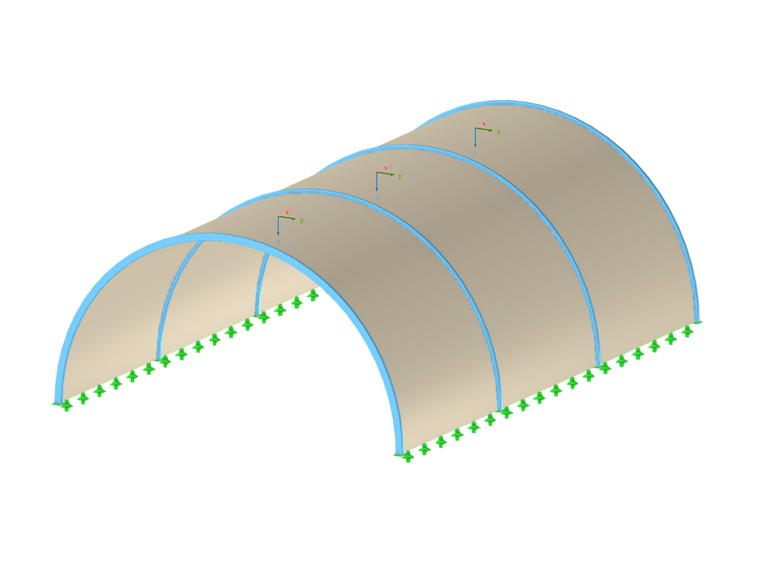As already described in Chapter Form-Finding Process, the stiffness of the overall structure has an influence on the form-finding.
In RFEM 6, it is possible to use temporary states or construction stages in connection with the form-finding. This can be very useful when mapping real assembly or construction processes.
Basically, there are two options to model temporary states:
- Defining structure modifications
- Considering the construction process with the Construction Stages Analysis (CSA) add-on
To compare both variants, an arch-supported membrane is used as an example model. The structure consists of three membrane panels and four steel arches. The membranes are laterally connected to the beams and anchored at their bottom edges; the steel arches are fixed in the foundation.
In the original model, the steel arches are not held by the construction supports. The steel arches are assumed in the form-finding process. They represent flexible boundary conditions for the membrane surfaces. The membranes are provided with the defined prestress that the beams have to withstand. The form-finding process not only results in a prestressed shape of the membrane surfaces, but also a distorted shape and the internal forces of the rigid parts of the structure. The steel arches are deformed under the load from the membranes according to their stiffness.
For example purposes, there is a different loading prestress for each membrane panel. The first panel is defined with an isotropic prestress of nx = ny = 1 kN/m, the second and third panels with an orthotropic prestress. The loading prestress in the second panel is nx = 1 kN/m and ny = 2 kN/m while the third panel has a loading prestress of nx = 2 kN/m and ny = 1 kN/m.
In the original model, the prestress load case results in deformations and cutting forces for the steel arches:
In order to show the construction stage, the modified model gets the construction supports under the steel arches. These are modeled in a simplified form as line supports.
Defining Structure Modifications
As already described, the modified model contains line supports that support the steel arches and are only effective in the prestress load case. These line supports are deactivated by the structure modification for the load combinations. You can easily add it to the combination wizard for generating load combinations.
The line supports are then only active during the form-finding process; they are not taken into account for other load combinations (similarly to removing the construction supports). All loads that the supports had to withstand for the form-finding are then taken up by the steel arches.
In the modified model, there are no deformations or cutting forces for the steel arches in the prestress load case:
In Load Combination 1, the construction supports are removed. Furthermore, the self-weight has an effect on the form-found structure. Since the temporary supports are deactivated in this step, the beams transfer all loads and deform. The deformation of the beams also affects the loading prestress in the membranes.
Working with Construction Stages (Construction Stages Analysis (CSA) Add-on)
Also in this case, the modified model contains line supports that support the steel arches and are only effective in the prestress load case. These line supports are deactivated in Construction Stage 2.
The line supports are then only active during the form-finding process (Construction Stage 1); they are not taken into account for other construction stages (similar to removing the construction supports). All loads that the supports had to withstand for the form-finding are then taken up by the steel arches.
In the modified model, there are no deformations or cutting forces for the steel arches in the prestress load case:
In Construction Stage 2, the construction supports are removed. Furthermore, the self-weight has an effect on the form-found structure. Since the temporary supports are deactivated in this step, the beams transfer all loads and are deformed. The deformation of the beams also affects the loading prestress in the membranes.
Summary
If the construction supports are not used for the rigid arches during assembly, they will deform when they are tensioned. This corresponds to the form-finding process without using the temporary supports. The prestress occurring after tensioning the structure corresponds to the prestress resulting from the form-finding process.
If, on the other hand, the beams are supported by mounting bearings during the tensioning of the membrane, this can be simulated by temporary states. After tensioning the membrane, support reactions occur in the construction supports. After removing the construction supports, the steel arches have to withstand these forces and are deformed. As a result, the internal forces in the membrane are changed. This corresponds to the form-finding process performed for the structure supported by temporary supports after starting an empty load case. Since the temporary supports are deactivated in this step, the beams transfer all loads and are deformed. The deformation of the beams also affects the loading prestress in the membranes. This change of state, caused by deactivating the temporary supports in RFEM, corresponds to the process of removing construction supports.
The Construction Stages Analysis (CSA) add-on provides more flexibility when working with structure modifications.









